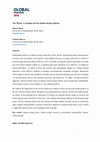Thesis Chapters by Desiree Smal

This thesis is an investigation into environmental sustainability in the South African fashion in... more This thesis is an investigation into environmental sustainability in the South African fashion industry, with a particular focus on the role of design therein. The fashion and textile industry is a significant contributor to the South African economy and a major user of human and natural resources. It is through the use of resources – natural, constructed and human – that the industry is also supposedly damaging to the natural environment and the people working within it. Notable authors on environmentally sustainable design and, in particular, environmentally sustainable fashion design, seem to suggest that a holistic approach to environmental sustainability is fundamental to the implementation thereof. Design has the ability to direct change, and thus design and designers have the potential to drive holistic sustainable practices in the fashion system.
The question this research therefore poses is what the role of environmental sustainability should be in a design-driven approach in the South African fashion industry; interrogated through an exploratory and descriptive case study. The case study consists of three purposively selected sub-units that operate within an environmentally sustainable focus in their fashion businesses, and that design, produce, and retail fashion products. The aim of the research was to explore, through a snapshot of the South African fashion system, the implementation of environmental sustainability in the fashion industry in South Africa, in order to determine what role fashion design practice can have in developing environmental sustainability in the fashion system.
The most notable finding of the research highlights the immense difficulty of operating as a fashion business from an environmentally sustainable focus in South Africa due to the lack (and unsuitability) of resources that can be considered environmentally sustainable. The declining textile industry of South Africa makes it either almost impossible, or very costly, to work within an environmentally sustainable framework, and is a major impediment in the implementation of environmental sustainability in praxis. Therefore, those businesses that decide to operate within an environmentally sustainable framework do so because of inherent personal values and ethics.
The second aspect identified in the survey of scholarship and underpinned by the findings, is a need for a transformative approach with regard to design praxis and how design praxis can influence consumer eco-consciousness. The research concludes with a recommended framework that suggests a holistic and integrated approach to design-driven environmental sustainability in the South African fashion industry, and elaborates on the role of the fashion designer in the implementation of environmental sustainability in the fashion system. The holistic and integrated approach should extend into fashion design education, requiring a fundamental shift in current fashion design education in South Africa.
Papers by Desiree Smal
Routledge eBooks, Mar 19, 2024
DIY, alternative cultures & society, Mar 12, 2024
The international journal of designed objects, 2013

This chapter forms part of a six-section exploration of sustainable practices and views from arou... more This chapter forms part of a six-section exploration of sustainable practices and views from around the globe. Section Six particularly focuses on Africa, with only 2 essays, 6.1 and 6.2, that focus on South Africa. The essay, emanates from a finding of my doctoral research completed in 2015, places emphasis on the role of fashion design as practice in driving change in the local fashion and textile industry. This essay explores a particular finding of the larger doctoral study, that of a key strategy that should drive sustainable practices. Fletcher and Grose (2012) reflect on the role of design in successful sustainable approaches and practices. The essay presents the current challenges of what is referred to in South Africa as a sunset industry. The essay further reflects on an environmental-advantage strategy and explores shifts in thinking of a sustainable praxis paradigm and possible knowledge gap by designers in the discipline. The finding from the doctoral study that alludes to a holistic approach in thinking about sustainability, forms the basis for a suggested framework for sustainable fashion design praxis that can be applied in the South African fashion industry.

Image & Text : a Journal for Design, 2008
Awareness of the impact current practices have on the environment is applicable to all spheres of... more Awareness of the impact current practices have on the environment is applicable to all spheres of life, industries, and countries, with emphasis placed on the wise and sparing use of resources. Similarly, eco fashion has become one of the lifestyle issues of the twenty-first century with some designers in the global and local fashion arenas, developing their collections around this concept. Yet, as pointed out by Lee and Sevier (2008) in discussions and debates on eco fashion, differing interpretations and endorsements of eco practices emerge. Does eco fashion refer to organic products, recycling, re-use, restoration? There are questions as to whether the concept could even be considered compatible with the idea of fashion. Breds, Hjort and Kruger (2002 : 27) maintain that many in the textile and apparel industry '... believe that there is a contradiction in working with sustainability [eco] and fashion'. This quote seems to be a true reflection of the fashion world where the consumer is constantly presented with seasonal and inter-seasonal changes. That consumers have an innate desire to have the next best thing is an idiom widely embraced in the fashion industry. How then, would it be possible to ensure, instil or develop eco-awareness and acceptance in the current consumer-based culture?
BRILL eBooks, May 8, 2011
... In volume production (also referred to as mass-production) re-using clothing for retail becom... more ... In volume production (also referred to as mass-production) re-using clothing for retail becomes problematic, as large quantities of the same product in a varied size ... Susan Kaiser14, refers to this as the bathtub and ties this type of thinking in a holistic manner. ... 5. Design as core 6 ...
Tydskrif vir Gesinsekologie en Verbruikerswetenskappe, 2016
The female innovation-generation consumer's evaluation of traditional and virtual displays in Sou... more The female innovation-generation consumer's evaluation of traditional and virtual displays in South African clothing retail environments Die bevindings van die studie dui daarop dat die-Me S van Heerden
Fashion Forward, 2011
... In volume production (also referred to as mass-production) re-using clothing for retail becom... more ... In volume production (also referred to as mass-production) re-using clothing for retail becomes problematic, as large quantities of the same product in a varied size ... Susan Kaiser14, refers to this as the bathtub and ties this type of thinking in a holistic manner. ... 5. Design as core 6 ...

This thesis is an investigation into environmental sustainability in the South African fashion in... more This thesis is an investigation into environmental sustainability in the South African fashion industry, with a particular focus on the role of design therein. The fashion and textile industry is a significant contributor to the South African economy and a major user of human and natural resources. It is through the use of resources – natural, constructed and human – that the industry is also supposedly damaging to the natural environment and the people working within it. Notable authors on environmentally sustainable design and, in particular, environmentally sustainable fashion design, seem to suggest that a holistic approach to environmental sustainability is fundamental to the implementation thereof. Design has the ability to direct change, and thus design and designers have the potential to drive holistic sustainable practices in the fashion system. The question this research therefore poses is what the role of environmental sustainability should be in a design-driven approach in the South African fashion industry; interrogated through an exploratory and descriptive case study. The case study consists of three purposively selected sub-units that operate within an environmentally sustainable focus in their fashion businesses, and that design, produce, and retail fashion products. The aim of the research was to explore, through a snapshot of the South African fashion system, the implementation of environmental sustainability in the fashion industry in South Africa, in order to determine what role fashion design practice can have in developing environmental sustainability in the fashion system. The most notable finding of the research highlights the immense difficulty of operating as a fashion business from an environmentally sustainable focus in South Africa due to the lack (and unsuitability) of resources that can be considered environmentally sustainable. The declining textile industry of South Africa makes it either almost impossible, or very costly, to work within an environmentally sustainable framework, and is a major impediment in the implementation of environmental sustainability in praxis. Therefore, those businesses that decide to operate within an environmentally sustainable framework do so because of inherent personal values and ethics. The second aspect identified in the survey of scholarship and underpinned by the findings, is a need for a transformative approach with regard to design praxis and how design praxis can influence consumer eco-consciousness. The research concludes with a recommended framework that suggests a holistic and integrated approach to design-driven environmental sustainability in the South African fashion industry, and elaborates on the role of the fashion designer in the implementation of environmental sustainability in the fashion system. The holistic and integrated approach should extend into fashion design education, requiring a fundamental shift in current fashion design education in South Africa.
01. Diseño de Periódicos _____está profundamente enraizado en realidades imprácticas, y es más un... more 01. Diseño de Periódicos _____está profundamente enraizado en realidades imprácticas, y es más un proceso abstracto que orgánico. _____emplea herramientas de navegación que impiden al lector llegar al contenido que desea leer, en el menor tiempo posible. _____provee un ambiente donde el buen contenido encuentra una forma atractiva de mostrarse, además de incrementar el número de lectores que lo usen. _____Todas las anteriores. _____Ninguna de las anteriores.

Fundamental shifts are evident in design (Giacomin, 2014). Firstly, ensuring that fashion design ... more Fundamental shifts are evident in design (Giacomin, 2014). Firstly, ensuring that fashion design praxis becomes more meaningful, with regard to value-adding relevance to design-with-intent in relation to fashion design education (Smal & Harvey, 2017). Secondly, to integrate research and design at a fourth year level where students embark on a research project that culminates in a collection. To emphasise design-with-intent, we opted to focus the research and subsequently design on a human-centred approach, to find effective methods in teaching environmentally sustainable strategies. Muratovski (2016) suggests that research should be externally-driven and inform design praxis, instead of adopting an inward-looking process that promotes personal self-expression. To apply a design-with-intent approach, with the primary focus on human-centred design (HCD) and environmental sustainability, we developed a tool to assist students as a way-finding method. We explore the application of the t...

The concept of fashion has attracted a great deal of interest from a variety of academic discipli... more The concept of fashion has attracted a great deal of interest from a variety of academic disciplines such as history, culture, anthropology, sociology, psychology and semiotics to name a few. This has often resulted in tension between different approaches. At a conference held in England in 2009 concerning the future of fashion studies, a number of fashion scholars such Rebecca Arnold, Christopher Breward, Professor Stella Bruzzi and many others, deliberated on the methodologies and research agendas that have emerged in the growing research area of fashion studies. It was noted that although fashion studies has gained momentum over the last decade as an interdisciplinary field of research, fashion as an academic subject has remained weak. Research activities in the field of fashion studies include the contribution of authors from other fields of study that preserve their own disciplinary identities (Riello & McNeil 2010:7). In order to develop the area of fashion studies as an inter...

This thesis is an investigation into environmental sustainability in the South African fashion in... more This thesis is an investigation into environmental sustainability in the South African fashion industry, with a particular focus on the role of design therein. The fashion and textile industry is a significant contributor to the South African economy and a major user of human and natural resources. It is through the use of resources – natural, constructed and human – that the industry is also supposedly damaging to the natural environment and the people working within it. Notable authors on environmentally sustainable design and, in particular, environmentally sustainable fashion design, seem to suggest that a holistic approach to environmental sustainability is fundamental to the implementation thereof. Design has the ability to direct change, and thus design and designers have the potential to drive holistic sustainable practices in the fashion system. The question this research therefore poses is what the role of environmental sustainability should be in a design-driven approach in the South African fashion industry; interrogated through an exploratory and descriptive case study. The case study consists of three purposively selected sub-units that operate within an environmentally sustainable focus in their fashion businesses, and that design, produce, and retail fashion products. The aim of the research was to explore, through a snapshot of the South African fashion system, the implementation of environmental sustainability in the fashion industry in South Africa, in order to determine what role fashion design practice can have in developing environmental sustainability in the fashion system. The most notable finding of the research highlights the immense difficulty of operating as a fashion business from an environmentally sustainable focus in South Africa due to the lack (and unsuitability) of resources that can be considered environmentally sustainable. The declining textile industry of South Africa makes it either almost impossible, or very costly, to work within an environmentally sustainable framework, and is a major impediment in the implementation of environmental sustainability in praxis. Therefore, those businesses that decide to operate within an environmentally sustainable framework do so because of inherent personal values and ethics. The second aspect identified in the survey of scholarship and underpinned by the findings, is a need for a transformative approach with regard to design praxis and how design praxis can influence consumer eco-consciousness. The research concludes with a recommended framework that suggests a holistic and integrated approach to design-driven environmental sustainability in the South African fashion industry, and elaborates on the role of the fashion designer in the implementation of environmental sustainability in the fashion system. The holistic and integrated approach should extend into fashion design education, requiring a fundamental shift in current fashion design education in South Africa.

Awareness of the impact current practices have on the environment is applicable to all spheres of... more Awareness of the impact current practices have on the environment is applicable to all spheres of life, industries, and countries, with emphasis placed on the wise and sparing use of resources. Similarly, eco fashion has become one of the lifestyle issues of the twenty-first century with some designers in the global and local fashion arenas, developing their collections around this concept. Yet, as pointed out by Lee and Sevier (2008) in discussions and debates on eco fashion, differing interpretations and endorsements of eco practices emerge. Does eco fashion refer to organic products, recycling, re-use, restoration? There are questions as to whether the concept could even be considered compatible with the idea of fashion. Breds, Hjort and Kruger (2002 : 27) maintain that many in the textile and apparel industry '... believe that there is a contradiction in working with sustainability [eco] and fashion'. This quote seems to be a true reflection of the fashion world where th...
The International Journal of Designed Objects, 2013
International Journal of Fashion Design, Technology and Education
The conference proceedings are published by the Design Education Forum of Southern Africa (DEFSA)... more The conference proceedings are published by the Design Education Forum of Southern Africa (DEFSA) on the following website: www.defsa.org.za











Uploads
Thesis Chapters by Desiree Smal
The question this research therefore poses is what the role of environmental sustainability should be in a design-driven approach in the South African fashion industry; interrogated through an exploratory and descriptive case study. The case study consists of three purposively selected sub-units that operate within an environmentally sustainable focus in their fashion businesses, and that design, produce, and retail fashion products. The aim of the research was to explore, through a snapshot of the South African fashion system, the implementation of environmental sustainability in the fashion industry in South Africa, in order to determine what role fashion design practice can have in developing environmental sustainability in the fashion system.
The most notable finding of the research highlights the immense difficulty of operating as a fashion business from an environmentally sustainable focus in South Africa due to the lack (and unsuitability) of resources that can be considered environmentally sustainable. The declining textile industry of South Africa makes it either almost impossible, or very costly, to work within an environmentally sustainable framework, and is a major impediment in the implementation of environmental sustainability in praxis. Therefore, those businesses that decide to operate within an environmentally sustainable framework do so because of inherent personal values and ethics.
The second aspect identified in the survey of scholarship and underpinned by the findings, is a need for a transformative approach with regard to design praxis and how design praxis can influence consumer eco-consciousness. The research concludes with a recommended framework that suggests a holistic and integrated approach to design-driven environmental sustainability in the South African fashion industry, and elaborates on the role of the fashion designer in the implementation of environmental sustainability in the fashion system. The holistic and integrated approach should extend into fashion design education, requiring a fundamental shift in current fashion design education in South Africa.
Papers by Desiree Smal
The question this research therefore poses is what the role of environmental sustainability should be in a design-driven approach in the South African fashion industry; interrogated through an exploratory and descriptive case study. The case study consists of three purposively selected sub-units that operate within an environmentally sustainable focus in their fashion businesses, and that design, produce, and retail fashion products. The aim of the research was to explore, through a snapshot of the South African fashion system, the implementation of environmental sustainability in the fashion industry in South Africa, in order to determine what role fashion design practice can have in developing environmental sustainability in the fashion system.
The most notable finding of the research highlights the immense difficulty of operating as a fashion business from an environmentally sustainable focus in South Africa due to the lack (and unsuitability) of resources that can be considered environmentally sustainable. The declining textile industry of South Africa makes it either almost impossible, or very costly, to work within an environmentally sustainable framework, and is a major impediment in the implementation of environmental sustainability in praxis. Therefore, those businesses that decide to operate within an environmentally sustainable framework do so because of inherent personal values and ethics.
The second aspect identified in the survey of scholarship and underpinned by the findings, is a need for a transformative approach with regard to design praxis and how design praxis can influence consumer eco-consciousness. The research concludes with a recommended framework that suggests a holistic and integrated approach to design-driven environmental sustainability in the South African fashion industry, and elaborates on the role of the fashion designer in the implementation of environmental sustainability in the fashion system. The holistic and integrated approach should extend into fashion design education, requiring a fundamental shift in current fashion design education in South Africa.
This essay explores a particular finding of the larger doctoral study, that of a key strategy that should drive sustainable practices. Fletcher and Grose (2012) reflect on the role of design in successful sustainable approaches and practices. The essay presents the current challenges of what is referred to in South Africa as a sunset industry. The essay further reflects on an environmental-advantage strategy and explores shifts in thinking of a sustainable praxis paradigm and possible knowledge gap by designers in the discipline. The finding from the doctoral study that alludes to a holistic approach in thinking about sustainability, forms the basis for a suggested framework for sustainable fashion design praxis that can be applied in the South African fashion industry.